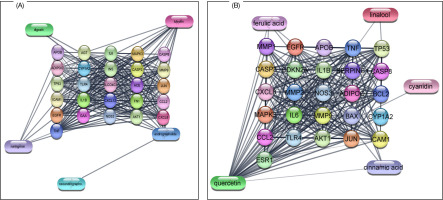1. INTRODUCTION
Plants are a valuable source of therapeutic agents, providing an abundance of bioactive compounds with diverse medicinal properties. The investigation of phytochemical constituents in these botanical sources has played a crucial role in discovering and developing novel drugs. Phytochemical screening, a fundamental aspect of plant research, is essential for uncovering the pharmacological potential hidden within various plant species, paving the way for identifying new therapeutic agents (Gautam et al., 2023; Salar et al., 2023). Throughout history, civilizations have harnessed the healing potential of plants, leveraging their innate chemical diversity to address ailments and afflictions. This practice continues to be a focal point in modern pharmaceutical research, where the scrutiny of plant-derived compounds through phytochemical screening stands as a critical starting point (Ali et al., 2023; Ekbbal et al., 2022).
The phytochemical screening means not only demonstrating the diversity of compounds but also illustrating the promising pharmaceutical properties (Gautam et al., 2021; Gaurav, 2022). Through advanced analytical techniques, the elucidation of chemical structures and the understanding of their interactions with biological systems are revealed, paving the way for targeted drug design and development (Gautam et al., 2023; Ranjan, 2022). Phytochemical screening, the systematic analysis of plant extracts for bioactive compounds, has emerged as a pivotal methodology in uncovering a rich reservoir of potential therapeutic agents (Gad et al., 2013).
Plants have historically been integral to traditional medicine, providing remedies and healing agents across diverse cultures. The pursuit of harnessing the healing power of plants through phytochemical screening endeavors to unveil the complex chemical compositions inherent in botanical species. This screening process has led to the discovery of a myriad of bioactive compounds, ranging from alkaloids and flavonoids to terpenes and phenolics, presenting a diverse array of potential medicinal applications (Gautam et al., 2021).
The 2,2-diphenyl-1-picrylhydrazyl (DPPH) method used the antioxidant potential of plant via scavenging free radicals. The significance of antioxidant activity lies in its role in protecting the body from oxidative stress. Antioxidants neutralize free radicals, preventing cellular damage and slowing down the aging process. Thus, plants rich in antioxidants are of high interest for therapeutic purposes, and their evaluation through methods such as the DPPH assay helps identify potential candidates for the development of health-promoting products (Ekbbal et al., 2022; Ranjan et al., 2020).
High-performance thin-layer chromatography (HPTLC) is a powerful technique used for the qualitative and quantitative analysis of plant extracts. It allows for the profiling of chemical constituents based on their migration behavior on a silica plate under a specific solvent system. HPTLC is particularly useful in the separation, identification, and quantification of bioactive compounds, providing a “fingerprint” of the plant’s chemical composition. This technique is highly sensitive, cost-effective, and capable of analyzing multiple compounds simultaneously (Khan et al., 2024; Ranjan, 2022; Gaurav et al., 2022; Khan et al., 2024).
The rationale behind this study is to assess the therapeutic potential of Indian medicinal plants by profiling their chemical constituents and evaluating their antioxidant activity. With the growing interest in herbal remedies, it is essential to validate scientifically the medicinal claims associated with these plants. The combination of HPTLC fingerprinting and DPPH antioxidant assessment offers a comprehensive approach to understand the bioactive components of plants such as Lavandula angustifolia and Andrographis paniculata. This study aims to provide a detailed chemical fingerprinting for each plant, enabling better identification and standardization of herbal products. The antioxidant assays help to identify plants with strong free radical scavenging capabilities, potentially offering new options for managing oxidative stress and related diseases.
2. MATERIALS AND METHODS
2.1. Chemicals and Reagents
All chemicals and reagents acquired and used were of analytical grade: distilled Water, ferric chloride, absolute alcohol, chloroform, acetic acid, Dragendroff’s reagent, concentrated sulfuric acid, hydrochloric acid, sodium carbonate, bismuth carbonate, sodium iodide, glacial acetic acid, lead acetate solution, iodine solution, ninhydrin solution, acetone, ethanol, methanol, etc.
2.2. Collection and Authentication of Plant Material
The plant material of Andrographis paniculata and Lavandula angustifolia was purchased from the Universal Biotech (New Delhi, India). In order to enhance the credibility, the raw material was authenticated by Prof. Vijay Malik, Department of Botany, Ch. Charan Singh University (CCSU), Meerut, India on 12 September 2023. For future reference, the voucher (specimen No. CCSU/Bot/PB/473) was submitted to the laboratory (Gaurav, 2022).
2.3. Preparation of Extracts
The herbal raw materials of Andrographis paniculata (leaves) and Lavandula angustifolia (aerial parts) were sorted, cleaned, and dried in hot air oven at 50°C for 24 hours. Drugs were grinded into coarse powder using a grinder. Powdered drugs were soaked in distilled water for 24 hours (1:8 w/v). Content was filtered using four-layered muslin cloth (marc was further used for extraction, followed by two repetitions). The extract was filtered and concentrated at 60°C temperature on a water bath and the extract was stored at 4°C for further analysis (Ekbbal et al., 2023; Gaurav, 2022).
2.4. Phytochemical Screening
The aqueous extract of Andrographis paniculata (kalmegh) and Lavandula angustifolia (English lavender) were analyzed through qualitative preliminary phytochemical screening to detect and evaluate the presence of key phytoconstituents, such as alkaloids, terpenoids, glycosides, phenols, tannins, flavonoids, etc. (Desai and Chanda, 2014; Lakhera et al., 2015; Shamkuwar et al., 2012).
2.5. In vitro anti-oxidant analysis
In vitro analysis was performed to determine the potential of Andrographis paniculata (kalmegh) and Lavandula angustifolia (English lavender) to scavenge free radicals that proportionate to their anti-oxidant activity. In brief, 1 mg/mL solution of each extract was prepared in distilled water, followed by preparation of concentration ranging 1000 to 31.5 µL/mL to determine the concentration-dependant effect of each extract against free radicals. In this analysis, DPPH, 2,2'-azino-bis (3-ethylbenzothiazoline-6-sulfonic acid) diammonium salt (ABTS), nitric oxide (NO), and ferric-reducing antioxidant power (FRAP) assays were performed for each extract at different dilutions. In vitro anti-oxidant activity was performed as per the reference protocol of Polu et al., (2017) and Gaurav (2022), with some modification.
2.6. HPTLC analysis
2.6.1. Preparation of sample
In all, 500 mg of Andrographis paniculata (Kalmegh) and Lavandula angustifolia (English lavender) extract was weighed and transferred in a 10-mL volumetric flask and vortexed, followed by sonication for 10 minutes for proper dissolution of the extract. The obtained solution was centrifuged and supernatant was collected. The obtained supernatant was filtered through 0.22-µ post-exposure prophylaxis (PEP) syringe filter so that no traces of undissolved particles remain in the solution. The filtrate was analyzed through HPTLC assay for chromatographic separation and fingerprinting profiling (Khan et al., 2022; Gaurav et al., 2020).
2.6.2. Chromatographic conditions and detection level
The filtered sample was applied to a thin layer chromatography (TLC) plate using a Camag Linomat HPTLC applicator, with an application volume of 4 µL for each track. The TLC plate spots were dried using an air dryer and developed in a pre-saturated TLC development chamber containing a solvent system of toluene, ethyl acetate, and glacial acetic acid (4:5:1, v/v), saturated for 30 minutes. The plate was developed to a height of 70 mm. After development, the plate was removed from the chamber, dried using an air dryer, and visualized under a Camag Ultraviolet (UV) visualizer in daylight, at UV 254 nm and UV 366 nm. The plate was then scanned using a TLC scanner 4 at UV 254 nm and UV 366 nm, and the chromatogram of the developed plate was recorded. Subsequently, the TLC plate was derivatized with anisaldehyde sulfuric acid reagent and heated to visualize bands on each track. Images of the derivatized TLC plate were captured at UV 366 nm in daylight. The plate was then scanned at UV 366 nm and UV 520 nm. All images and developed chromatograms were recorded for data analysis.
2.7. Liquid chromatography–mass spectrometry (LC-MS) analysis
The LC-MS profiling of all extracts was conducted by following a standardized reference protocol. The analysis was performed using an ACQUITY ultra-performance liquid chromatography (UPLC) system (Waters Corp., USA) equipped with a C18 column (4.6 µm, 2.1×100 mm), a binary solvent delivery system, an auto-sampler, and a tunable mass spectrometry (MS) detector. Data acquisition and processing were managed using software provided by Waters (Manchester, UK). For compound separation, water and acetonitrile were utilized as mobile phases with 500 L/h and 50 L/h nebulizer gas, cone gas flow rates and source temperature at 100°C. The capillary voltage was adjusted to 3.0 KV, and the cone voltage was set at 40 KV. Spectral data for metabolite were identified based on their mass-to-charge ratio of an ion (m/z) values, which were cross-verified with the information available from the reported literature, MassBank, and PubChem databases (Agrawal and Pal, 2013; Gautam et al., 2023; Uroos et al., 2017).
2.8. Network pharmacology analysis
2.8.1. Selection of potential myocardial infarction disease targets
The GeneCards platform was utilized to select different gene targets. To identify targets related to myocardial Infarction (MI), keywords such as “Myocardial Infarction Disease” were entered into the UniProt gene database (https://www.uniprot.org/), which is known for its extensive publicly accessible gene collection, and GeneCards (https://www.genecards.org/) (Ekbbal et al., 2023; Ranjan et al., 2022).
2.8.2. Development of network of compounds and proteins
The compound-gene network was developed to identify potential interacting target genes. The selected chemical targets were uploaded to the STRING database (https://string-db.org/), a tool for gene interaction network analysis and functional enrichment. Additionally, Cytoscape version 3.8.2 was utilized for integration analysis. This involved constructing a network of protein–protein interactions (PPI) and compound–protein interactions, with the interaction data analyzed using metrics, such as the number of nodes, edges, average node degree, and average local clustering coefficient. The study addressed nearly all functional relationships between the expressed proteins, compounds, and proteins within the network (Gaurav et al., 2022).
2.8.3. Gene ontology (GO) analysis
Gene ontology analysis was performed to determine the multi-targeted and therapeutic approach of metabolites identified in Andrographis paniculata (kalmegh) and Lavandula angustifolia (English lavender) using reference protocol with some modifications. In this analysis, the genes involved in myocardial infarction (a cardiac disease) and showing potential intreaction with the metabolites of Andrographis paniculata (kalmegh) and Lavandula angustifolia (English lavender) were screened to exhibit their pathophysiological pathways involved in the management of myocardial infarction and associated complications. For this analysis, Metascape (https://metascape.org;) or Network analyst (https://www.networkanalyst.ca) tools were used to conduct gene and disease association analysis. The most significant outcomes were expressed in the form of a network and bar chart of genes and disease, and represented to intimate the multi-targeted effect of Andrographis paniculata (kalmegh) and Lavandula angustifolia (English lavender) based on their actives found in the extract through LC-MS analysis.
2.9. Statistical analysis
Each measurement was taken in triplicate. The data were represented statistically as mean ± standard deviation (SD), followed by Student’s t-test. Comparative analysis of the data set was performed using GrapPad Prism (5.0). For measurements, the statistical significance level was considered as p < 0.05–p < 0001.
3. RESULTS
Different extracts of the plant material were prepared as per the standard protocol and the extractive yield of each plant was found comparable to the details provided in the Ayurvedic Pharmacopoeia of India. The extractive yield of the plants varied significantly, reflecting differences in their phytochemical content and extraction efficiency. The extractive yields of Andrographis paniculata (kalmegh) and Lavandula angustifolia (English lavender) were found as 18.642 ± 0.786% w/w and 17.378 ± 0.623% w/w, respectively.
3.1. Phytochemical investigation
The phytochemical analysis of Andrographis paniculata and Lavandula angustifolia revealed the presence of various bioactive compounds with significant medicinal properties. Both plants exhibited a high concentration of glycosides (+++), flavonoids (++ in A. paniculata, and +++ in L. angustifolia), tannins (+++), phenols (+++), and saponins (+++), indicating strong antioxidant, anti-inflammatory, and antimicrobial potential. The presence of phenols and flavonoids suggests their role in combating oxidative stress and preventing chronic diseases.
Lavandula angustifolia showed a notable presence of steroids (+++), which were absent in A. paniculata, indicating possible hormonal or anti-inflammatory effects unique to lavender. Terpenoids, known for their antibacterial and anticancer activities, were moderately present (++) in both plants. Starch (++) and cellulose (+++) were found in high amounts, highlighting their structural and energy-storing properties. The presence of proteins (+++) in both plants indicated potential nutritional and therapeutic applications. Notably, alkaloids were absent in both species, suggesting that their therapeutic effects are largely derived from other phytochemicals. This diverse phytochemical profile emphasized the medicinal potential of A. paniculata and L. angustifolia, supporting their use in traditional and modern medicine. The results of phytochemical analysis have been represented in Table 1.
Table 1
Phytochemical analysis of various extracts of plant material was affected to identify various chemical constituents present in the extracts.
3.2. In vitro anti-oxidant activity
In vitro anti-oxidant activity of different extracts was determined to evaluate the scavenging effect of each extract against free radicals that demonstrate the anti-oxidant effect. The in vitro antioxidant activity of Andrographis paniculata and Lavandula angustifolia was evaluated using DPPH, ABTS, NO, and FRAP assays. The results indicate that Lavandula angustifolia exhibited stronger antioxidant potential than Andrographis paniculata in most assays. For the DPPH assay, Lavandula angustifolia demonstrated a lower half-maximum inhibition concentration (IC50) value (154.00 ± 1.78 µg/mL), compared to Andrographis paniculata (235.10 ± 5.28 µg/mL), suggesting higher free radical scavenging capacity. A similar trend was observed in the ABTS assay, where Lavandula angustifolia showed an IC50 of 191.90 ± 2.73 µg/mL, which was lower than Andrographis paniculata (238.60 ± 4.28 µg/mL), further supporting its superior antioxidant activity.
In the nitric oxide (NO) scavenging assay, Lavandula angustifolia again exhibited a stronger effect with an IC50 of 156.90 ± 1.37 µg/mL whereas Andrographis paniculata showed a higher IC50 of 239.90 ± 4.23 µg/mL. However, in the FRAP assay, Andrographis paniculata demonstrated a slightly better reducing power with an IC50 of 235.10 ± 6.27 µg/mL, compared to Lavandula angustifolia (257.90 ± 0.73 µg/mL). The findings of the study suggest that Lavandula angustifolia possesses significant antioxidant properties, indicating its potential as a natural antioxidant source for therapeutic applications. The results of anti-oxidant analysis have been represented in Table 2 and Figure 1.
Table 2
IC50 regarding anti-oxidant activity of different extracts.
Figure 1
DPPH, ABTS, NO, and FRAP anti-oxidant activity of Andrographis paniculata and Lavandula angustifolia extracts with ascorbic acid as a standard. DPPH: 2,2-diphenyl-1-picrylhydrazyl; ABTS: 2,2'-azino-bis(3-ethylbenzothiazoline-6-sulfonic acid); NO: nitric oxide; and FRAP: ferric-reducing antioxidant power.
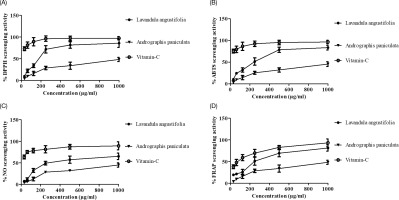
3.3. HPTLC analysis
3.3.1. HPTLC analysis ofAndrographis paniculata
The HPTLC analysis of Andrographis paniculata reveals distinct chromatographic profiles and densitometric data under UV 254 nm, UV 366 nm, and post-derivatization conditions. The chromatograms display well-separated bands corresponding to various secondary metabolites, indicated by densitometric peaks with different retention factor (Rf) values. At UV 254 nm, the densitogram shows six distinct peaks, with the most prominent one at Rf ~0.1, indicating the presence of a major UV-absorbing compound. Peaks at Rf ~0.9 and ~0.5 suggest the presence of additional compounds contributing to the phytochemical profile. At UV 366 nm, fluorescence visualization highlights seven peaks, with the dominant peak remaining at Rf ~0.1. The fluorescence intensity of peaks at Rf ~0.7 and ~0.9 indicates compounds with significant fluorescent characteristics, probably flavonoids or other phenolic compounds. Post-derivatization, the densitogram reveals enhanced detection with nine peaks. The peaks at Rf ~0.9 and ~0.7 display the highest absorbance, indicating a strong reaction with derivatization reagent, which enhances the visibility of specific functional groups. The results of HPTLC analysis have been represented in Figure 2.
Figure 2
HPTLC fingerprinting of Andrographis paniculata. Upper panel of the figure shows the TLC plate viewed at different wavelength and post-derivatization with anisaldehyde sulfuric acid reagent. Lower panel of the figure shows the densitometric chromatogram of Andrographis paniculata L. at UV 254 nm, UV 366 nm, and post-derivatization. HPTLC: high-performance thin-layer chromatography.
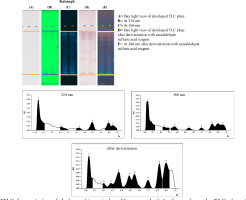
3.3.2. HPTLC analysis of Lavandula angustifolia (English lavender)
The HPTLC analysis of Lavandula angustifolia (English lavender) reveals a detailed chemical fingerprinting at UV 254 nm, UV 366 nm, and post-derivatization. The chromatographic results are presented as distinct bands on the plate, and corresponding densitograms illustrate the separation and identification of compounds based on their Rf values and intensities. At UV 254 nm, the densitogram shows nine prominent peaks, indicating the presence of multiple components in the sample. The highest peak observed at an approximate Rf = 0.6 suggests a compound with high concentration or strong absorbance at this wavelength. Other peaks, such as those at Rf = 0.1 and 0.4, represent additional components with varying concentrations. At UV 366 nm, the densitogram exhibits changes in peak intensities, implying that certain compounds fluoresce more prominently at this wavelength. Peaks at approximate Rf = 0.1, 0.35, and 0.6 are more distinct, highlighting fluorescent compounds potentially corresponding to flavonoids or aromatic compounds.
Post-derivatization analysis shows enhanced resolution of the peaks, with some shifts in intensity. This indicates the successful interaction of derivatizing agents with specific functional groups, allowing better visualization of compounds. Notable peaks at Rf = 0.1, 0.6, and 0.8 suggest the presence of terpenoids or phenolic derivatives commonly found in lavender. Overall, the HPTLC profile confirms the complexity of Lavandula angustifolia constituents, demonstrating the presence of multiple phytochemicals. Further identification of individual compounds would require comparison with standard references or advanced techniques such as mass spectrometry. The results of HPTLC analysis have been represented in Figure 3 and Table 3.
Figure 3
HPTLC fingerprinting of Lavandula angustifolia. Upper panel of the figure shows the TLC plate viewed at different wavelength (UV 254 nm, 366 nm, and 520 nm) and post-derivatization with anisaldehyde sulfuric acid reagent. Lower panel of the figure shows the chromatogram of densitometric analysis of Lavandula angustifolia at different conditions. HPTLC: high-performance thin-layer chromatography.
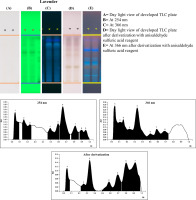
Table 3
HPTLC analysis of kalmegh and lavender at different wavelengths (UV 254 nm, 366 nm, and 520 nm). The matched retention factor (Rf) values, corresponding wavelengths, and the presence (+) or absence (-) of peaks are also provided.
3.4. LC-MS analysis
The LC-MS analysis of kalmegh and English lavender extracts showed various bioactive constituents. In Andrographis paniculata (kalmegh), key phytochemicals identified included luteolin (324.7 m/z) and naringenin (311.7 m/z), both are flavonoids with antioxidant properties. Additionally, chrysin (255.5 m/z) was detected, which is known for its anti-inflammatory and anticancer potential. The presence of neoandrographolide (481.1 m/z) and andrographolide (331.3 m/z) highlights the medicinal importance of this plant, particularly in immune modulation and hepatoprotection. Other compounds identified were digoxin (739.1 m/z), a cardiac glycoside, and paniculide C (261.4 m/z), which may also contribute to the plant’s pharmacological activities. Furthermore, 3,5-dimethoxycinnamic acid (C11H12O4; 209.5 m/z) was detected, suggesting potential antimicrobial and anti-inflammatory benefits.
In Lavandula angustifolia (lavender), cinnamic acid (148.9 m/z) and ferulic acid (193.3 m/z) were identified, both are phenolic compounds with strong antioxidant and anti-aging properties. Linalool (155.1 m/z), a major volatile component, contributes to the plant’s calming and anxiolytic properties. The presence of 12-hydroxy lauric acid (217.4 m/z) suggests antimicrobial activity. Additionally, flavonoids cyanidin-3-O-rhamnoside (435.3 m/z) and quercetin (283.1 m/z) indicate potent antioxidant and anti-inflammatory properties.
3.5. Network pharmacology
3.5.1. Compound–protein interaction
Network pharmacology reveals interactions between bioactive compounds and target proteins, which is essential in drug discovery and disease treatment. In this analysis, compound–protein interaction network was developed to illustrate how specific compounds interact with multiple proteins, forming a complex biological network, and provides insights into the potential pharmacological mechanisms underlying the therapeutic effects of Andrographis paniculata and Lavandula angustifolia compounds.
The results of Andrographis paniculata and Lavandula angustifolia network pharmacology showed that the developed network includes several key proteins and bioactive compounds, highlighting their interconnectivity. Compounds such as digoxin, andrographolide, and neotanshinone appear to interact with multiple target proteins. These proteins include significant signaling molecules, such as IL-6, TNF, and AKT1, which are known for their roles in inflammatory and metabolic pathways. The presence of multiple interactions demonstrates the polypharmacological approach of a single compound modulating multiple targets, enhancing therapeutic efficacy, and reducing adverse effects.
In Lavandula angustifolia, several key bioactive compounds, such as quercetin, ferulic acid, linalool, cinnamic acid, and cyanidin, exhibit strong interactions with various target proteins. Among these, quercetin demonstrates the highest degree of connectivity, highlighting its extensive potential for diverse biological activities. Network analysis reveals that critical hub proteins, such as epidermal growth factor receptor EGFR, matrix metalloproteinase-9 (MMP9), TP53, AKT1, and IL-6, play central roles in mediating the pharmacological effects of these compounds. The high connectivity of these proteins suggests their involvement in key pathways related to inflammation, cancer progression, and oxidative stress, underscoring the therapeutic potential of Lavandula angustifolia.
In the developed network of Andrographis paniculata, key proteins, such as caspase-3 (CASP3), mitogen-activated protein kinase 3 (MAPK3), and endothelial nitric oxide synthase (NOS3), play crucial roles in apoptosis, inflammation, and vascular function. The presence of CASP3 suggests an involvement in apoptosis regulation, while MAPK3 is linked to cellular signaling pathways that control cell differentiation, proliferation, and stress responses. NOS3 is integral to vascular homeostasis and endothelial functioning. These findings imply that the analyzed compounds may exert their effects through multiple pathways, leading to broad-spectrum therapeutic effects.
In Lavandula angustifolia, the presence of multiple inflammatory and apoptosis-related proteins, including CASP3, caspase-8 (CASP8), TNF, and Bcl-2-associated X (BAX), suggests that the compounds may have a regulatory effect on cell survival and immune response pathways. Connections between these proteins and bioactive compounds suggest potential therapeutic implications, particularly in inflammation-associated disorders and cancer. Notably, quercetin, a flavonoid widely known for its antioxidant and anti-inflammatory properties, exhibits interactions with several key signaling proteins, such as AKT1, IL-6, and MMP9, reinforcing its potential role in modulating critical biological processes. Similarly, EGFR, a crucial player in cell proliferation and survival, is targeted by multiple compounds, hinting at possible anticancer effects through inhibition of EGFR-mediated pathways. Furthermore, the interaction of IL-6 and TNF with multiple compounds, such as digoxin, luteolin, ferulic acid, linalool, etc., indicates their anti-inflammatory potential, as these cytokines are critical mediators of inflammation (Figure 4).
3.5.2. Gene ontology and DisGeNET (Gene Disease Database) analysis
Gene ontology (GO) analysis provides an intense understanding of biological processes as well as molecular functions. The analysis results showed that among the top GO terms identified, biological processes involved in interspecies interaction representing the targeted proteins play roles in cell movement and host–pathogen interactions, which are critical for immune response and progression of disease. Additionally, response to stimulus, developmental processes suggest that the analyzed proteins contribute to cellular adaptation, organismal development, and regulation of biological processes.
It is also demonstrated that the bioactive components of Andrographis paniculata play a vital role in immune modulation and antiviral response implications. This aligns with the observed interactions in compound–protein network, where inflammatory mediators and immune-related proteins are highly interconnected.
DisGeNET analysis (Figure 5) provides insights into the potential disease associations of identified target proteins. The results revealed significant associations with various diseases, particularly related to metabolic and inflammatory conditions. Among the top-ranked diseases, “diabetic retinopathy” and “fatty liver disease” showed strong associations. These findings suggest that the identified proteins and their interacting compounds could play important roles in metabolic disorders, offering potential therapeutic targets for diabetes-related complications. Additionally, “peripheral vascular diseases” and “abdominal aortic aneurysm” indicate a strong link to cardiovascular health, reinforcing the therapeutic potential of these compounds in managing vascular dysfunction. Presence of “lip and oral cavity carcinoma” and “malignant neoplasm of the mouth” highlights the relevance of target proteins in cancer pathology. This suggests that the bioactive compounds analyzed may have anticancer properties by modulating pathways involved in tumor progression. Inflammatory disorders, such as “chronic periodontitis,” “nephritis,” and “pneumonitis” further emphasize the role of these compounds in managing immune and inflammatory conditions.
Figure 5
Gene ontology and DisGeNet analysis of Andrographis paniculata in myocardial infarction or cardiac disease and associated ailments.
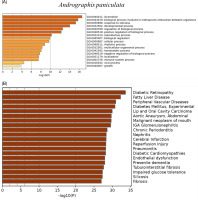
Cerebral infarction and presenile dementia are among the top disease associations, indicating potential neuroprotective effects. This suggests that the identified compounds may have applications in neurodegenerative diseases, possibly through anti-inflammatory and neuroprotective mechanisms. Additionally, “tubulointerstitial fibrosis,” “silicosis,” and “fibrosis” indicate potential applications in treating fibrotic diseases, which are characterized by excessive tissue scarring and organ dysfunction. The integration of network pharmacology, gene ontology, and DisGeNET analysis reveals a multifaceted approach to drug discovery. The identified bioactive compounds exhibit polypharmacological properties by interacting with multiple proteins involved in key biological processes and disease pathways. This systems-based approach enhances our understanding of how these compounds may exert therapeutic effects across different disease domains.
The analysis of compound–protein interactions, gene ontology enrichment, and DisGeNET disease associations demonstrates pharmacological landscape of the identified bioactive compounds. The network pharmacology approach reveals key target proteins involved in inflammatory, metabolic, and cardiovascular processes, while GO and DisGeNET analysis highlight their functional and disease-related significance. These findings underscore the potential of these compounds in developing novel therapeutics for various diseases, paving the way for further pharmacological exploration and clinical translation.
The GO enrichment analysis of Lavandula angustifolia provide insight into the biological processes significantly associated with the identified target proteins. The most enriched GO term is locomotion, followed by biological processes involved in interspecies interactions, response to stimuli, and the regulation of biological processes. The high significance of locomotion as a biological process may be attributed to the involvement of key regulatory proteins in cell migration and metastasis, which are crucial in cancer progression and immune responses. Additionally, immune-related processes, such as response to stimuli and immune system processes, indicate that the bioactive compounds may influence immune function, potentially contributing to anti-inflammatory or immunomodulatory effects.
Presence of terms such as positive and negative regulation of biological processes suggests a bidirectional regulatory mechanism, highlighting the complexity of these interactions. The regulation of homeostasis and growth-related processes further supports the hypothesis that the identified compounds may play a role in maintaining physiological balance, particularly in pathological conditions, such as cancer, metabolic disorders, and inflammatory diseases. The inclusion of processes, such as viral response and rhythmic processes, broaden the functional scope, implying potential antiviral effects or circadian rhythm regulation, which may be relevant in conditions such as metabolic syndrome and neurological disorders.
The DisGeNET analysis of Lavandula angustifolia presents the results of disease-enrichment analysis, linking the target proteins to various diseases based on DisGeNET analysis. Fatty liver disease emerges as the most significantly associated condition, followed by diabetic retinopathy, oral lichen planus (a chronic inflammatory skin condition), and experimental diabetes mellitus. A strong association with metabolic disorders, particularly fatty liver disease and diabetes-related conditions, suggests that bioactive compounds may exert beneficial effects in metabolic regulation. This aligns with previous research demonstrating that flavonoids, such as quercetin and phenolic acids, can improve insulin sensitivity, reduce oxidative stress, and mitigate hepatic lipid accumulation. The identification of cardiovascular diseases, such as acute myocardial infarction, aortic aneurysm, myocardial reperfusion injury, and endothelial dysfunction, highlights the potential cardioprotective effects of these compounds. Many of the target proteins, such as AKT1, MMP9, and IL-6, play critical roles in cardiovascular health, influencing processes such as vascular integrity, inflammation, and apoptosis. Presence of cerebrovascular conditions, such as cerebral infarction and transient ischemic attack, suggests additional neuroprotective effects, possibly mediated through anti-inflammatory and anti-oxidative mechanisms.
Moreover, the enrichment of cancer-related conditions, such as gastrointestinal carcinoid tumor and endometriosis of the uterus, reinforces the hypothesis that these bioactive compounds may exert anticancer effects. The targeting of key oncogenic proteins, such as EGFR, TP53, and c-Jun, provides a mechanistic basis for potential chemopreventive or therapeutic applications. Additionally, the presence of infection-related conditions, including pneumonitis and endotoxemia, suggests antimicrobial or immunomodulatory properties, which could be beneficial in managing infectious diseases and sepsis. The findings underscore the potential of these bioactive compounds in targeting a wide spectrum of diseases through multiple molecular pathways. The network analysis suggests that rather than acting through a single pathway, these compounds exert their effects through a multi-target approach, influencing various biological processes and disease states. This highlights the advantage of network pharmacology in drug discovery, as it allows for a holistic understanding of compound–protein interactions and their broader implications in the treatment of disease.
The interconnected nature of biological processes and disease associations based on the genes interacted with metabolites of Lavandula angustifolia suggests their potential combinatorial or synergistic effects. For instance, the combined targeting of inflammatory pathways by quercetin, ferulic acid, and cyanidin could lead to enhanced therapeutic outcomes in conditions such as diabetes, cardiovascular diseases, and cancer. Furthermore, the involvement of critical signaling nodes, such as AKT1 and IL-6, indicates that these compounds may modulate key signaling cascades involved in cell survival, inflammation, and metabolic regulation. The significance of fatty liver disease in the disease enrichment analysis warrants particular attention, given its rising global prevalence and limited treatment options. The potential role of bioactive compounds in modulating lipid metabolism, reducing oxidative stress, and attenuating inflammation provides a promising avenue for therapeutic intervention. Similarly, the presence of diabetic retinopathy and experimental diabetes mellitus suggests potential applications in diabetes management, possibly through mechanisms involving improved glucose homeostasis and endothelial protection.
Furthermore, the network pharmacology approach applied in this study highlights the multifaceted interactions between bioactive compounds and target proteins, offering insights into their potential therapeutic applications. The GO emphasizes the broad functional and pathological relevance of these interactions, particularly in metabolic disorders, cardiovascular diseases, cancer, and inflammation-related conditions. These findings provide a strong foundation for further research into the therapeutic potential of these natural compounds, emphasizing the need for experimental validation and clinical exploration.
4. DISCUSSION
Medicinal plants known for therapeutic properties because of their rich phytochemical profiles, with extractive yields have a crucial role in determining the availability of bioactive compounds. These yields reflect the efficiency of extraction processes and the composition of water-soluble constituents, which are significant in traditional medicine. In this study, extractive yields were measured for several plants using standard protocols, and the results aligned with the details provided in the Ayurvedic Pharmacopoeia of India. Among the plants tested, Andrographis paniculata’s (kalmegh) and Lavandula angustifolia’s (English lavender) extractive yield was found as 18.642 ± 0.786% ww and 17.378 ± 0.623% ww, respectively.
The phytochemical composition of Andrographis paniculata and Lavandula angustifolia confirms their therapeutic potential, emphasizing their role in traditional and modern medicine. The abundance of glycosides, flavonoids, and phenol, and the presence of tannins, suggests antimicrobial and wound-healing properties, which further support their medicinal applications. The high levels of saponins indicate potential immune-boosting and cholesterol-lowering effects.
A key distinction between the two plants is the presence of steroids in L. angustifolia, suggesting additional hormonal or anti-inflammatory benefits. The moderate presence of terpenoids in both species reinforces their potential antibacterial and antifungal properties. The absence of alkaloids directs attention toward other active compounds responsible for their medicinal effects. Overall, this study validates the diverse bioactive composition of A. paniculata and L. angustifolia, highlighting their potential as natural therapeutic agents.
The antioxidant potential of various plants has been extensively studied using the DPPH assay (Gaurav, 2022; Salar et al., 2023). The in vitro antioxidant analysis of Andrographis paniculata and Lavandula angustifolia highlights their ability to scavenge free radicals, demonstrating their therapeutic potential. Lavandula angustifolia consistently exhibited stronger antioxidant activity in most assays, as indicated by its lower IC50 values in DPPH, ABTS, and NO scavenging assays. Lavandula angustifolia showed significant antioxidant activity in ABTS and NO assays, reinforcing its potential as a powerful natural antioxidant (Dobros et al., 2022; Idris et al., 2022; Uthirapandi et al., 2021). Andrographis paniculata demonstrated slightly better reducing power in FRAP assay, indicating its ability to donate electrons and reduce oxidative damage. This suggests that while Lavandula angustifolia may be more effective in neutralizing free radicals, Andrographis paniculata still holds considerable antioxidant potential.
Mustafa et al. (2023) (Mustafa and Chin, 2023)demonstrated the significant antioxidant capacity of Zingiber officinale (ginger), influenced by drying methods and solvents. Ethanol-extracted and sun-dried ginger exhibited the highest DPPH radical inhibition (95%), attributed to a 12.25-fold increase in total flavonoid content (TFC). Freeze-dried ginger also displayed strong activity (77%) with enhanced total phenolic content (TPC) and FRAP. Ethanol extraction was the most effective process, highlighting the importance of optimizing drying and extraction methods to enhance bioactive properties (Mustafa and Chin, 2023). Similarly, Dobros et al. (2022) studied Lavandula angustifolia and Lavandula x intermedia (a hybrid cross between English Lavender and Portuguese Lavender), revealing antiradical activity ranging from 104.58 to 206.77 µmol Trolox/g. Ultrasound-assisted extraction yielded the highest antioxidant activity, with L. angustifolia showing greater phenolic acid and flavonoid content, while L. x intermedia contained more coumarins. Dominant polyphenols, including rosmarinic acid and morin, significantly contributed to DPPH activity, emphasizing the role of cultivar and extraction methods (Dobros et al., 2022). Idris et al. (2022) found that methanol-extracted Andrographis paniculata (APE2) had strong DPPH activity (median effective concentration [EC50] = 397.0 µg/mL), linked to high andrographolide and phenolic content. APE2 also inhibited prostate cancer cell progression, demonstrating therapeutic potential.
Table 4
LC-MS analysis of Andrographis paniculata (kalmegh) and Lavandula angustifolia (English lavender).
Figure 6
Gene ontology and DisGeNet analysis of Lavandula angustifolia in myocardial infarction or cardiac disease and associated ailments.
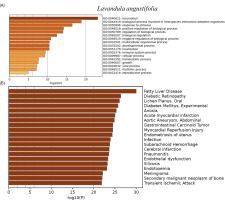
The HPTLC technique is one of the most robust, sensative, and accurate chromatographic techniques for quality-based standardization of medicinal plants. The HPTLC analysis of Andrographis paniculata and Lavandula angustifolia provided distinct chromatographic profiles, revealing the complexity of their phytochemical compositions that represent unique fingerprinting and validate standardized aspect for authenticaton of the plants.
The significance of HPTLC profiling of Andrographis paniculata and Lavandula angustifolia provides a stadardized fingerprint of bioactive compounds known for their therapeutic properties (Dobros et al., 2022). The distinct chromatographic profiles obtained under different detection conditions (UV, visible light, and post-derivatization) allow for the efficient differentiation of compounds, supporting the standardization of herbal medicines. This profiling technique also aids in quality control, ensuring the consistency and authenticity of plant-based products (Ranjan et al., 2023b; Salar et al., 2023).
The LC-MS analysis of Andrographis paniculata and Lavandula angustifolia revealed a diverse range of bioactive compounds, reinforcing their medicinal significance. In Andrographis paniculata, the presence of flavonoids, such as luteolin, naringenin, and chrysin, highlights its strong antioxidant and anti-inflammatory properties, which contribute to its protective effects against oxidative stress and inflammation (Pamunuwa et al., 2016; Peterson et al., 2006; Sassi et al., 2017). The identification of neoandrographolide and andrographolide further supports its immune-modulating and hepatoprotective benefits, making it valuable in liver-related disorders. Detection of digoxin suggests potential cardiac benefits, while paniculide C and 3,5-dimethoxycinnamic acid indicate additional antimicrobial and anti-inflammatory properties (Singh et al., 2011).
In Lavandula angustifolia, cinnamic acid and ferulic acid contribute to its potent antioxidant and anti-aging effects. The presence of linalool underscores its anxiolytic and calming properties, commonly associated with English lavender’s therapeutic use. Additionally, cyanidin-3-O-rhamnoside and quercetin enhance its antioxidant and anti-inflammatory potential. These findings validate the traditional medicinal applications of both plants and highlight their potential for pharmaceutical and therapeutic formulations (Lodhi and Kori, 2021; Sarray et al., 2020).
Network pharmacology provides a holistic approach for understanding interactions between bioactive compounds and target proteins, offering valuable insights into their therapeutic potential (Gautam, 2022; Ranjan, 2022; Salar et al., 2023). The analysis of Andrographis paniculata and Lavandula angustifolia highlights the interconnected nature of their bioactive compounds and key signaling proteins, demonstrating their polypharmacological effects. For Andrographis paniculata, compounds such as digoxin, andrographolide, and neotanshinone interact with key proteins such as IL-6, TNF, and AKT1, which are involved in inflammatory and metabolic pathways (Chun et al., 2010; Pandur et al., 2021). These interactions suggest potential applications in immune modulation, hepatoprotection, and cardiovascular health. The involvement of proteins such as CASP3 and MAPK3 further indicates its functions in apoptosis and cellular signaling, reinforcing the broad-spectrum pharmacological benefits of this plant (Khan et al., 2018; Lin et al., 2014).
Similarly, in Lavandula angustifolia, bioactive compounds such as quercetin, ferulic acid, and linalool interact with hub proteins such as EGFR, TP53, and IL-6. These connections suggest significant therapeutic applications, particularly in anti-inflammatory, neuroprotective, and anticancer mechanisms. The enrichment of metabolic and cardiovascular diseases in DisGeNET analysis supports their potential roles in managing conditions such as diabetes, fatty liver disease, and myocardial infarction. Moreover, the network pharmacology approach confirms the multi-target effects of these compounds, emphasizing their potential for developing novel therapeutics for inflammatory, metabolic, and cardiovascular disorders. Further experimental validation is needed to confirm these interactions and optimize their clinical applications.
5. CONCLUSION
This comprehensive study of Andrographis paniculata and Lavandula angustifolia through phytochemical screening, in vitro antioxidant assays, and HPTLC, LC-MS, and network pharmacology analyses highlights their substantial pharmacological potential. Phytochemical screening confirmed the presence of flavonoids, phenolics, and terpenoids, contributing to their diverse biological activities. A strong free radical scavenging activity observed in in vitro antioxidant assays supports their role in managing oxidative stress and preventing related diseases. HPTLC provided a distinctive fingerprint profile, aiding in standardization and validation of the authenticity of these medicinal plants. LC-MS analysis identified key bioactive compounds such as andrographolide, digoxin, quercetin, and ferulic acid, known for their antioxidant, anti-inflammatory, and immunomodulatory properties. Network pharmacology analysis highlighted interactions with vital proteins such as IL-6, TNF, AKT1, and EGFR, suggesting potential applications in managing inflammatory disorders and cardiovascular diseases. DisGeNET analysis linked these bioactives to metabolic, fibrotic, and vascular diseases, including myocardial infarction.
Future studies should focus on in vivo validations, clinical trials, and development of formulations to establish these plants as promising candidates for novel therapeutic interventions.
ACKNOWLEDGMENT
The authors thank IIMT College of Medical Sciences, IIMT University (IIMTU), Ganga Nagar-250001, Meerut, Uttar Pradesh, India, for providing facilities and support to complete this study.


